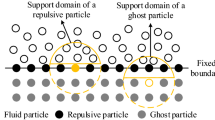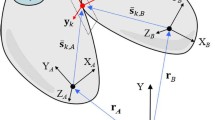Abstract
Simulation of incompressible fluid flow-elastic structure interactions is targeted by using fully-Lagrangian mesh-free computational methods. A projection-based fluid model (moving particle semi-implicit (MPS)) is coupled with either a Newtonian or a Hamiltonian Lagrangian structure model (MPS or HMPS) in a mathematically-physically consistent manner. The fluid model is founded on the solution of Navier-Stokes and continuity equations. The structure models are configured either in the framework of Newtonian mechanics on the basis of conservation of linear and angular momenta, or Hamiltonian mechanics on the basis of variational principle for incompressible elastodynamics. A set of enhanced schemes are incorporated for projection-based fluid model (Enhanced MPS), thus, the developed coupled solvers for fluid structure interaction (FSI) are referred to as Enhanced MPS-MPS and Enhanced MPS-HMPS. Besides, two smoothed particle hydrodynamics (SPH)-based FSI solvers, being developed by the authors, are considered and their potential applicability and comparable performance are briefly discussed in comparison with MPS-based FSI solvers. The SPH-based FSI solvers are established through coupling of projection-based incompressible SPH (ISPH) fluid model and SPH-based Newtonian/Hamiltonian structure models, leading to Enhanced ISPH-SPH and Enhanced ISPH-HSPH. A comparative study is carried out on the performances of the FSI solvers through a set of benchmark tests, including hydrostatic water column on an elastic plate, high speed impact of an elastic aluminum beam, hydroelastic slamming of a marine panel and dam break with elastic gate.
Similar content being viewed by others
References
Lucy L. B. A numerical approach to the testing of fission hypothesis [J]. Astronomical Journal, 1997, 82: 1013–1024.
Gingold R. A., Monaghan J. J. Smoothed particle hydrodynamics: Theory and application to non-spherical stars [J]. Monthly Notices of the Royal Astronomical Society, 1977, 181: 375–389.
Koshizuka S., Oka Y. Moving-particle semi-implicit method for fragmentation of incompressible fluid [J]. Nuclear Science and Engineering, 1996, 123: 421–434.
Fourey G. Développement d’une méthode de couplage fluide structure SPH Eléments Finis en vue de son application à l’hydrodynamique navale [D]. Doctoral Thesis, Nantes, France: Ecole Centralede Nantes, 2012.
Fourey G., Oger G., Le Touzé D. et al. Violent fluidstructure interaction simulations using a coupled SPH/FEM method [J]. IOP Conference Series: Materials Science and Engineering, 2010, 10(1): 012041.
Li Z., Leduc J., Nunez-Ramirez J. et al. A non-intrusive partitioned approach to couple smoothed particle hydrodynamics and finite element methods for transient fluidstructure interaction problems with large interface motion [J]. Computational Mechanics, 2015, 55(4): 697–718.
Fourey G., Hermange C., Le Touzé D. et al. An efficient FSI coupling strategy between smoothed particle hydrodynamics and finite element methods [J]. Computer Physics Communications, 2017, 217: 66–81.
Antoci C., Gallati M., Sibilla S. Numerical simulation of fluid-structure interaction by SPH [J]. Computers and Structures, 2007, 85(11-14): 879–890.
Rafiee A., Thiagarajan K. P. An SPH projection method for simulating fluid-hypoelastic structure interaction [J]. Computer Methods in Applied Mechanics and Engineering, 2009, 198(33-36): 2785–2795.
Oger G., Brosset L., Guilcher P. M. et al. Simulations of hydro-elastic impacts using a parallel SPH model [J]. International Journal of Offshore and Polar Engineering, 2010, 20(3): 181–189.
Eghtesad A., Shafiei A. R., Mahzoon M. A new fluid–solid interface algorithm for simulating fluid structure problems in FGM plates [J]. Journal of Fluids and Structures, 2012, 30: 141–158.
Hwang S. C., Khayyer A., Gotoh H. et al. Development of a fully Lagrangian MPS-based coupled method for simulation of fluid-structure interaction problems [J]. Journal of Fluids and Structures, 2014, 50: 497–511.
Hwang S. C., Park J. C., Gotoh H. et al. Numerical simulations of sloshing flows with elastic baffles by using a particle-based fluid-structure interaction analysis method [J]. Ocean Engineering, 2016, 118: 227–241.
Khayyer A., Falahaty H., Gotoh H. et al. An enhanced coupled Lagrangian solver for incompressible fluid and non-linear elastic structure interactions [J]. Journal of Japan Society of Civil Engineers, Ser. B2 (Coastal Engineering), 2016, 72(2): 1117–1122.
Khayyer A., Gotoh H., Falahaty H. et al. Towards development of a reliable fully-Lagrangian MPS-based FSI solver for simulation of 2D hydroelastic slamming [J]. Ocean Systems Engineering, 2017, 7(3): 299–318.
Foias C., Manley O., Rosa R. et al. Navier-Stokes equations and turbulence [M]. Cambridge, UK: Cambridge University Press, 2001, 364.
Bonet J., Lok T. S. L. Variational and momentum preservation aspects of smooth particle hydrodynamic formulations [J]. Computer Methods in Applied Mechanics and Engineering, 1999, 180(1-2): 97–115.
Marsden J. E., Hughes T. J. R. Mathematical foundations of elasticity [M]. New York, USA: Dover publication Inc., 1983, 556.
Kondo M., Suzuki Y., Koshizuka S. Suppressing localparticle oscillations in the Hamiltonian particle method for elasticity [J]. International Journal for Numerical Methods in Engineering, 2010, 81: 1514–1528.
Kondo M., Tanaka M., Harada T. et al. Elastic objects for computer graphic field using MPS method [C]. The 34th Annual Meeting of the Association for Computing Machineryʼs Special Interest Group on Graphics, San Diego, USA, 2007.
Suzuki Y., Koshizuka S. A Hamiltonian particle method for non-linear elastodynamics [J]. International Journal for Numerical Methods in Engineering, 2008, 74(8): 1344–1373.
Gotoh H., Khayyer A. Current achievements and future perspectives for projection-based particle methods with applications in ocean engineering [J]. Journal of Ocean Engineering and Marine Energy, 2016, 2(3): 251–278.
Gotoh H., Okayasu A. Computational wave dynamics for innovative design of coastal structures [J]. Proceedings of the Japan Academy Ser. B, 2017, 93(9): 525–546.
Khayyer A., Gotoh H., Shimizu Y. et al. On enhancement of energy conservation properties of projection-based particle methods [J]. European Journal of Mechanics-B/Fluids, 2017, 66: 20–37.
Khayyer A., Gotoh H., Shimizu Y. Comparative study on accuracy and conservation properties of two particle regularization schemes and proposal of an optimized particle shifting scheme in ISPH context [J]. Journal of Computational Physics, 2017, 332: 236–256.
Shao S., Lo E. Y. M. Incompressible SPH method for simulating Newtonian and non-Newtonian flows with a free surface [J]. Advances in Water Resources, 2003, 26(7): 787–800.
Gotoh H., Okayasu A., Watanabe Y. Computational wave dynamics (Advanced series on ocean engineering) [M]. Singapore: World Scientific, 2013, 234.
Liu G. R., Liu M. B. Smoothed particle hydrodynamics: A meshfree particle method [M]. Singapore: World Scientific, 2003, 472.
Violeau D. Fluid mechanics and the SPH method, theory and applications [M]. Oxford, UK: Oxford University Press, 2012, 616.
Monaghan J. J. Smoothed particle hydrodynamics [J]. Reports on Progress in Physics, 2005, 68(8): 1703–1759.
Liu M. B., Li S. M. On the modeling of viscous incompressible flows with smoothed particle hydrodynamics [J]. Journal of Hydrodynamics, 2016, 28(5): 731–745.
Koshizuka S. Current achievements and future perspectives on particle simulation technologies for fluid dynamics and heat transfer [J]. Journal of Nuclear Science and Technology, 2011, 48(2): 155–168.
Zhang A. M., Sun P. N., Ming F. R. et al. Smoothed particle hydrodynamics and its applications in fluidstructure interactions [J]. Journal of Hydrodynamics, 2017, 29(2): 187–216.
Gray J. P., Monaghan J. J., Swift R. P. SPH elastic dynamics [J]. Computer Methods in Applied Mechanics and Engineering, 2001, 190(49-50): 6641–6662.
Scolan Y. M. Hydroelastic behavior of a conical shell impacting on a quiescent-free surface of an incompressible liquid [J]. Journal of Sound and Vibration, 2004, 277(1-2): 163–203.
Allen T. Mechanics of flexible composite hull panels subjected to water impacts [D]. Doctoral Thesis, Auckland,New Zealand: University of Auckland, 2013.
Stenius I., Rosén A., Battley M. et al. Experimental hydroelastic characterization of slamming loaded marine panels [J]. Ocean Engineering, 2013, 74: 1–15.
Battley M., Allen T., Pehrson P. et al. Effects of panel stiffness on slamming responses of composite hull panels [C]. 17th International Conference Composite Materials, Edinburgh International Convention Centre (EICC), Edinburgh, UK, 2009.
Koshizuka S. Ryushiho (Particle method) [M]. Tokyo, Japan: Maruzen, 2005(in Japanese).
Belytschko T., Guo Y., Liu W. K. et al. A unified stability analysis of meshless particle methods [J]. International Journal for Numerical Methods in Engineering, 2000, 48(9): 1359–1400.
Belytschko T., Xiao S. P. Stability analysis of particle methods with corrected derivatives [J]. Computers and Mathematics with Applications, 2002, 43(3-5): 329–350.
Vignjevic R., Campbell J., Libersky L. D. A treatment of zero-energy modes in the smoothed particle hydrodynamics method [J]. Computer Methods in Applied Mechanics and Engineering, 2000, 184(1): 67–85.
Randles P. W., Libersky L. D. Normalized SPH with stress points [J]. International Journal for Numerical Methods in Engineering, 2000, 48(10): 1445–1462.
Timoshenko S., Woinowsky-Krieger S. Theory of plates and shells [M]. Second Edition, New York, USA: McGraw-Hill, 1959.
Long T., Hu D., Wan D. et al. An arbitrary boundary with ghost particles incorporated incoupled FEM-SPH model for FSI problems [J]. Journal of Computational Physics, 2017, 350: 166–183.
Liang D., He X., Zhang J. X. An ISPH model for flow-like landslides and interaction with structures [J]. Journal of Hydrodynamics, 2017, 29(5): 894–897.
Cercos-Pita J. L., Antuono M., Colagrossi A. et al. SPH energy conservation for fluid-solid interactions [J]. Computer Methods in Applied Mechanics and Engineering, 2017, 317: 771–791.
Gotoh H., Shibahara T., Sakai T. Sub-particle-scale turbulence model for the MPS method-Lagrangian flow model for hydraulic engineering [J]. Computational Fluid Dynamics Journal, 2001, 9(4): 339–347.
Khayyer A., Gotoh H. Enhancement of performance and stability of MPS meshfree particle method for multiphase flows characterized by high density ratios [J]. Journal of Computational Physics, 2013, 242: 211–233.
Author information
Authors and Affiliations
Corresponding author
Rights and permissions
About this article
Cite this article
Khayyer, A., Gotoh, H., Falahaty, H. et al. Towards development of enhanced fully-Lagrangian mesh-free computational methods for fluid-structure interaction. J Hydrodyn 30, 49–61 (2018). https://doi.org/10.1007/s42241-018-0005-x
Received:
Accepted:
Published:
Issue Date:
DOI: https://doi.org/10.1007/s42241-018-0005-x




